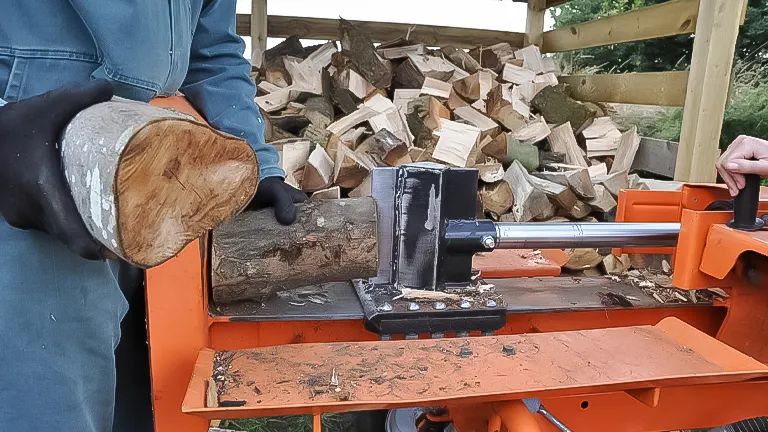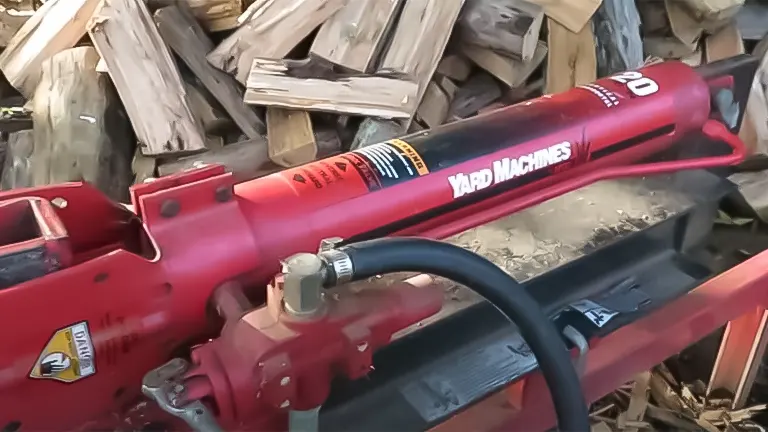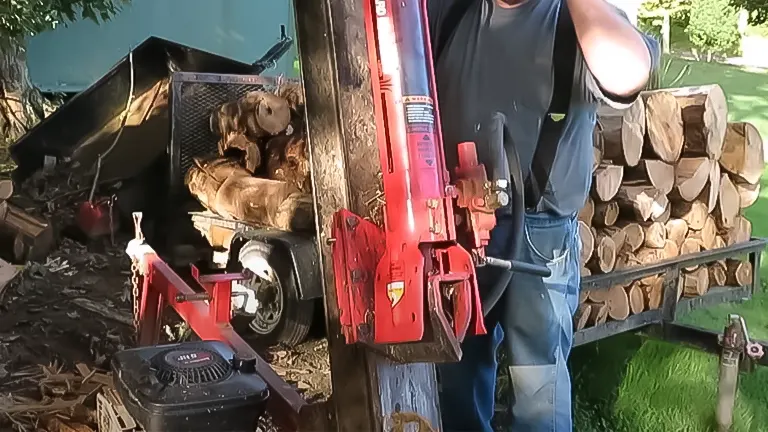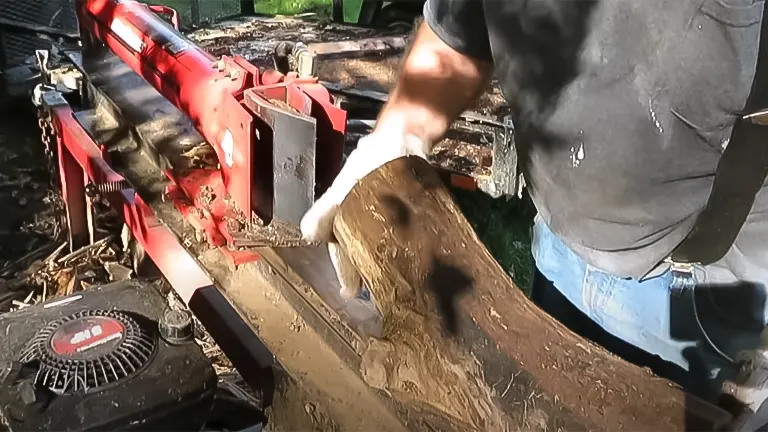How To Use A Log Splitter: A Beginner’s Guide
- February 19, 2024
- 0 comment
Utilizing a log splitter streamlines the firewood preparation process significantly, making it an indispensable tool as the chill of winter draws near. The focus of this guide is the utilization of the Yard Machine log splitter, a cost-effective choice that boasts a 5 horsepower Briggs & Stratton engine alongside a robust 20-ton cylinder.

This particular model, while being on the more affordable end of the spectrum, has demonstrated its versatility and efficiency in splitting a wide array of wood species. The secret to its success lies in the combination of its potent pressing force and the user’s adeptness at recognizing and aligning with the natural grain of the wood, enabling it to perform exceptionally well despite its reasonable price point.
List of How To Use A Log Splitter For Beginners:
- Get to Know Your Log Splitter
- Prepare the Log Splitter for Use
- Safety Precautions
- Operating the Log Splitter
- Efficient Workflow
Simplify Your Firewood Prep with Easy Log Splitter Tips
Preparing firewood for the colder months has traditionally been a labor-intensive task, demanding not just physical effort but also a good deal of skill and safety precautions. Yet, the introduction of a straightforward, yet effective, log splitter method is set to revolutionize this task, turning it into a simpler, more efficient, and safer process. This guide will walk you through a beginner-friendly approach to using a log splitter, designed to enhance your wood-splitting experience from the get-go:
Step 1: Get to Know Your Log Splitter

Understand the specifications and capabilities of your log splitter. For example, a 20-ton Yard Machine log splitter with a 5 horsepower Briggs & Stratton motor can handle almost any wood you need to split, as long as you understand the grain of the wood. Familiarize yourself with its parts, such as the cylinder, RAM, wedge, and how it can operate in both vertical and horizontal positions.
- Cylinder and Ram: The ram inside the cylinder pushes the wedge out against a plate, splitting the wood placed in between.
- Hydraulic System: Includes a reservoir for hydraulic fluid and a pump, essential for the splitter’s operation.
- Engine: A reliable Briggs & Stratton motor powers the machine, with straightforward maintenance requirements like regular oil and filter changes.
Step 2: Prepare the Log Splitter for Use

Check the log splitter’s hydraulic fluid levels and ensure the motor and pump are in good working condition. If your log splitter has been stationary for a while, inspect it for any needed maintenance, such as tire replacement or lubrication. Position the log splitter on a stable surface, preferably on a tarp to avoid moisture absorption from the ground.
- Safety First: Ensure that only the person operating the log splitter manipulates the wood and the controls. This prevents accidents, especially with the high risk of injury around the machine’s moving parts.
- Preparation: Before starting, check the machine’s hydraulic fluid levels, engine oil, and ensure the tires are in good condition if the splitter needs to be moved.
- Starting the Machine: Turn it on, engage the choke (if necessary), and start the engine. Familiarize yourself with the controls, particularly the lever that activates the ram.
- Splitting Wood:
- Place the wood against the plate, ensuring it is stable.
- Use the lever to press the wood against the wedge, splitting it.
- Always keep your hands clear of the moving parts and the sharp edges of the wedge.
Step 3: Safety Precautions

Safety should be your top priority. Never allow someone else to operate the lever while you handle the wood. The person placing the log must be the one to operate the lever to avoid accidents, such as cutting fingers with the wedge. Ensure no one stands too close to the splitter during operation to prevent injury from flying debris or the machine itself.
Step 4: Operating the Log Splitter

Start the engine following the manufacturer’s instructions, usually involving turning on the ignition, setting the choke, and pulling the starter cord. Place the log against the plate, ensuring it’s stable. Use the lever to push the wedge through the log. The automatic return feature on some models will retract the RAM once the log is split, readying the machine for the next log.
Step 5: Efficient Workflow

To minimize physical strain and maximize efficiency, keep the logs you intend to split on a trailer or elevated platform until ready to split. This reduces the need to bend over and pick up logs from the ground. After splitting, directly transfer the wood to a storage pile or area where it will be used, using a tarp to collect any smaller pieces or debris for easy cleanup.
Log Splitter Use for Beginners: Troubleshooting and Maintenance
Troubleshooting Tips:
- Loosening Difficult Bolts: If you encounter a bolt that’s hard to loosen on your log splitter, a dose of penetrating oil like WD-40 can work wonders. Spray it on and wait a few minutes before trying again. For those particularly stubborn bolts, grabbing a pair of pliers can give you the extra leverage you need, but be careful not to strip the bolt’s head.
- Non-Adjustable Models: Some log splitters may not feature adjustable parts as expected. If your model lacks this functionality, you might need to consider alternative splitting techniques or tools better suited to your needs. Always refer to the manufacturer’s manual or their official website for advice specific to your log splitter model.
- Issues with Parts Moving Out of Place: Should any component, like the wedge or ram, inadvertently move back to its original setting while in use, it likely wasn’t secured tightly enough. Double-check to ensure everything is properly tightened. Persistent issues might indicate wear on the threads of the bolt or part, necessitating a replacement.
Maintenance Recommendations:
- Regular Checks: Vibrations from regular use can loosen bolts and other components on your log splitter. Make it a routine to inspect and tighten bolts as needed to keep everything securely in place.
- Cleaning Post-Use: After each wood-splitting session, clean off any wood splinters, sawdust, or debris from your machine, focusing on areas around moving parts and any adjustment mechanisms. This prevents buildup that could impair functionality.
- Proper Storage: Store your log splitter in a location that’s dry and protected from the elements to avoid rust and deterioration. This ensures your equipment remains in good condition for longer.
- Lubrication: Adhere to the manufacturer’s guidelines for lubricating the log splitter’s moving parts. Regular lubrication not only facilitates smoother operation but also prolongs the life of your machine.
Additional Tips:
- Storage: Keeping the wood on a trailer or elevated surface until ready to split can save effort and reduce the need to bend over frequently.
- Work Area: Lay down a tarp under the splitting area to prevent wood from freezing to the ground in cold weather and to make cleanup easier.
Final Thoughts
Using a log splitter can greatly reduce the physical toll of preparing firewood while increasing efficiency. By understanding your machine’s components, operating it safely, and following best practices for maintenance and operation, you’ll ensure a productive and safe wood-splitting experience. Remember, the key to effective wood splitting is not just the machine’s power but also the operator’s knowledge and respect for the equipment.
Frequently Asked Questions
- What safety gear should I wear when using a log splitter?
Always wear protective gear, including safety glasses or goggles, durable gloves, ear protection (if operating a gas-powered splitter), and sturdy footwear to protect against potential injuries. - Can I use any type of wood in a log splitter?
While log splitters are designed to handle various types of wood, it’s important to consider the wood’s hardness and moisture content. Freshly cut (green) wood and softer woods are generally easier to split than dry, seasoned wood or harder species. - How do I know if the wood is too big to split?
Refer to your log splitter’s manual for maximum log size specifications. Generally, logs should not exceed the splitter’s length and diameter capacity. If a log is too large, you may need to pre-cut it with a chainsaw. - What is the difference between a vertical and horizontal log splitter?
A vertical log splitter allows you to split logs that are too heavy to lift, as you can roll them into position. A horizontal splitter requires lifting logs onto the machine, suitable for lighter and smaller logs. - How often should I perform maintenance on my log splitter?
Regular maintenance, including checking hydraulic fluid levels, inspecting hoses and connections for leaks, and sharpening the wedge, should be performed according to the manufacturer’s recommendations, typically at the start or end of the season. - Can I operate a log splitter on uneven ground?
Operating a log splitter on uneven ground can be dangerous. Always ensure the log splitter is on stable, level ground to prevent accidents or tipping. - How do I avoid getting my fingers caught in the log splitter?
Never place your hands near the moving parts of the splitter, and always use the control levers or buttons to operate the machine. If you need to adjust the log, ensure the machine is off and the wedge is retracted. - What do I do if the log splitter isn’t starting?
Check the basics first: ensure there’s enough fuel (for gas models), the machine is turned on, and the emergency stop switch (if present) is disengaged. Review the manufacturer’s troubleshooting guide for more specific advice. - Why isn’t the log splitter effectively splitting wood?
This could be due to several reasons, including a dull wedge, insufficient hydraulic fluid, or the wood type and condition. Ensure the splitter is properly maintained and consider pre-cutting or using a different technique for challenging logs. - Can I rent a log splitter instead of buying one?
Yes, many hardware stores and equipment rental services offer log splitters for rent. This can be a cost-effective option if you only need to use one occasionally.
We’d love to hear from you! Please share your experiences and insights on using a log splitter, especially if you’re a beginner. Your tips, challenges, and successes could greatly benefit others embarking on their firewood preparation journey. Drop your thoughts in the comments section below and help the community make informed choices and learn valuable techniques!

Edward Smith
Forestry AuthorWoodworking is about more than crafting; it's a harmonious connection with nature, mastering tools, and preserving our environment. I'm here to share my knowledge and experiences with you, forging a future where we can embrace wood's beauty and utility while safeguarding our forests' health and diversity.













Leave your comment